Key takeaways:
- Infographics effectively simplify complex information visually, making data more accessible and engaging for viewers.
- Key elements for successful infographics include clarity, visual hierarchy, and the integration of storytelling to foster emotional connections.
- Utilizing tools like Canva, Adobe Illustrator, and Venngage can streamline the infographic creation process for both beginners and advanced users.
- Sharing infographics effectively involves timing, tailoring content for specific platforms, and engaging with the audience to spark dialogue.
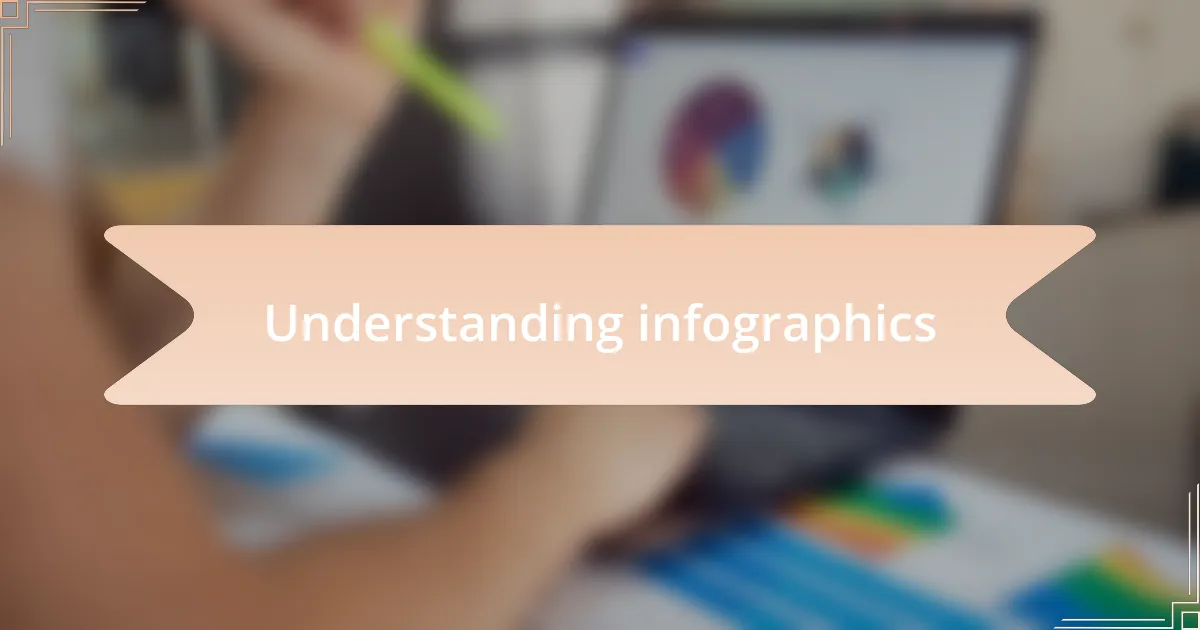
Understanding infographics
Infographics are a powerful way to convey complex information visually, simplifying data into digestible chunks. I remember the first time I saw an infographic that effortlessly explained a complicated process in just a few images and phrases—it sparked my curiosity and made me want to learn more. Isn’t it fascinating how a well-crafted visual can shift our understanding of a topic in seconds?
At their core, infographics blend graphic design with content strategy, marrying aesthetics with information. When I design an infographic, I always ask myself: what story am I trying to tell? This question guides my choices, from color schemes to layout, ensuring that each element contributes to a cohesive narrative. Have you ever thought about how vital each detail is in leading the viewer’s eye through the information?
Moreover, the emotional impact of an infographic can’t be underestimated. For instance, when I saw an infographic illustrating the effects of climate change with stark visuals and compelling statistics, it resonated deeply. It’s these visuals that can evoke feelings, prompting viewers not just to understand but to feel a sense of urgency. Can’t you see how this can drive meaningful action?
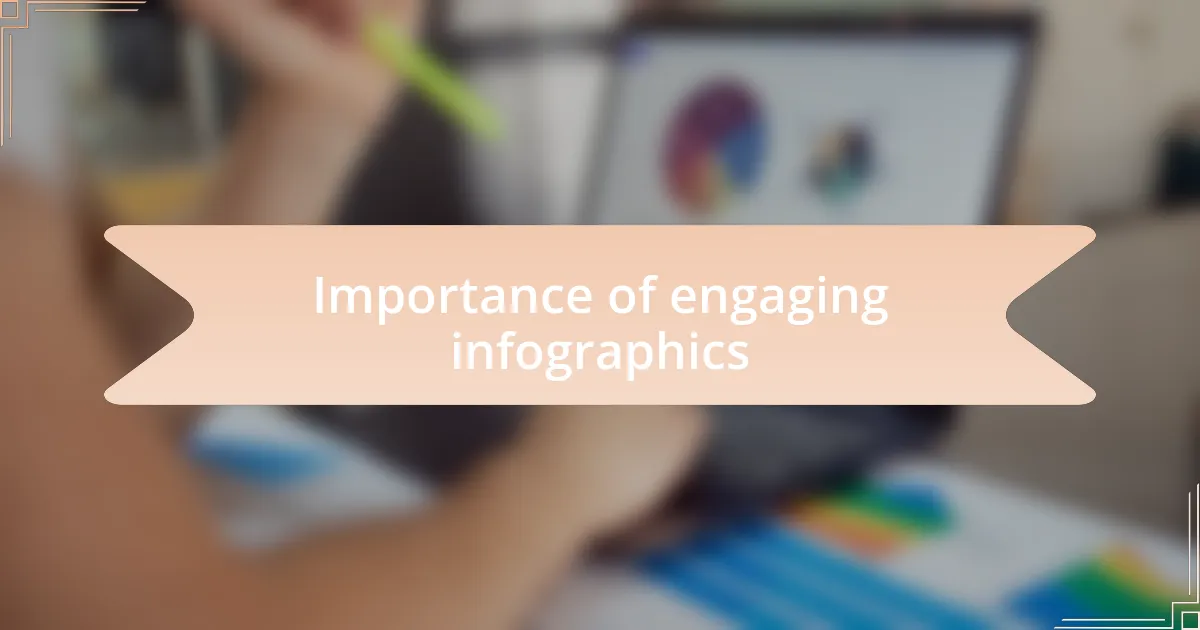
Importance of engaging infographics
Engaging infographics play a crucial role in capturing attention and holding it—something we all know can be a challenge in a world full of distractions. I recall a time when I stumbled upon an infographic about healthy eating; the vibrant colors and clear visuals compelled me to stop scrolling and take a closer look. Doesn’t it make sense that if our visuals are engaging, viewers are more likely to absorb the information rather than skim over it?
Moreover, the importance of infographics lies not only in their ability to inform but also to persuade. When I created an infographic for a community health initiative, I carefully chose images and compelling facts that emphasized the benefits of regular exercise. Seeing how it sparked conversation among peers was incredibly fulfilling. Have you experienced that moment when a visual ignites dialogue and encourages action?
Ultimately, engaging infographics serve as a bridge between complex data and the audience. In my experience, when I present statistics through striking visuals, the information becomes relatable and easier to grasp. Can we deny that a well-designed infographic can turn a mundane statistic into a memorable takeaway?
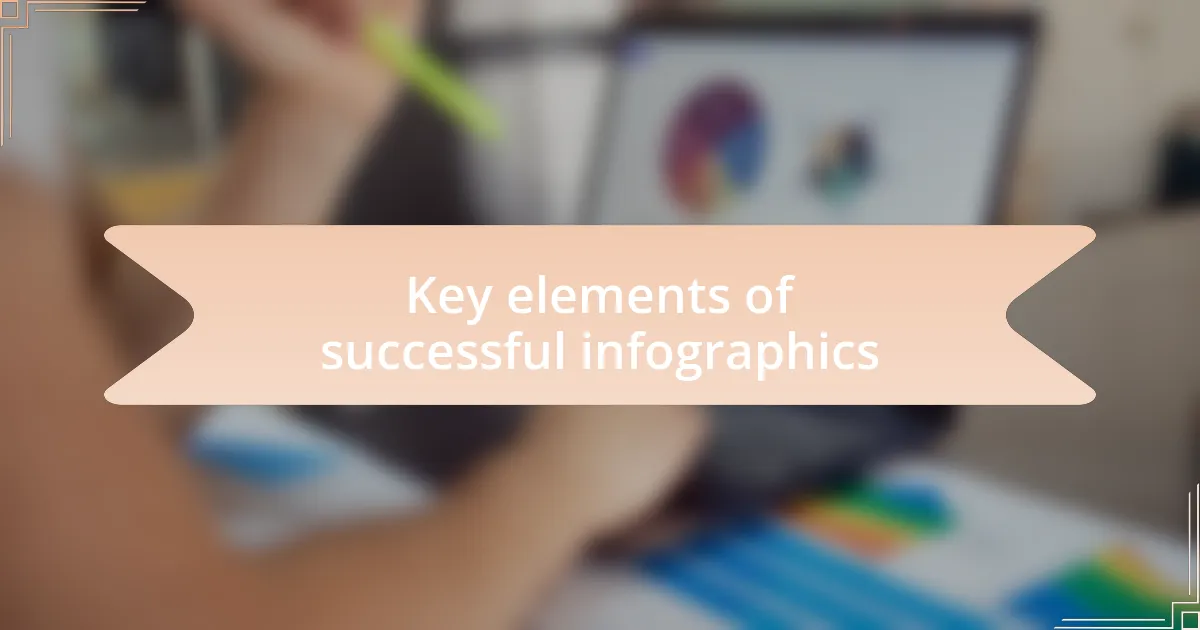
Key elements of successful infographics
One of the key elements of successful infographics is clarity. When I design an infographic, I focus on making sure that every piece of information feels accessible. For instance, I remember creating one that highlighted the steps for recycling effectively. By breaking down the process into simple visuals and concise text, not only did it make the concept clearer, but I also noticed that it encouraged people to take action instead of feeling overwhelmed.
Another essential component is visual hierarchy. In my experience, the arrangement of information can significantly affect a viewer’s comprehension. I once worked on an infographic about digital marketing trends; I used varying font sizes and colors to guide the reader’s eye through the data logically. This approach ensured that key points stood out, making it easier for the audience to digest the information. Doesn’t it make sense that when we prioritize what’s important visually, we capture the viewer’s attention more effectively?
Moreover, integrating storytelling is a potent technique that I often apply. When I crafted an infographic on mental health tips, I wove a narrative that related to my own struggles. By sharing a personal journey alongside the visuals, I created an emotional connection that resonated with many. It left me wondering how many people might be touched simply by presenting data through a relatable story. Isn’t that the true power of infographics?
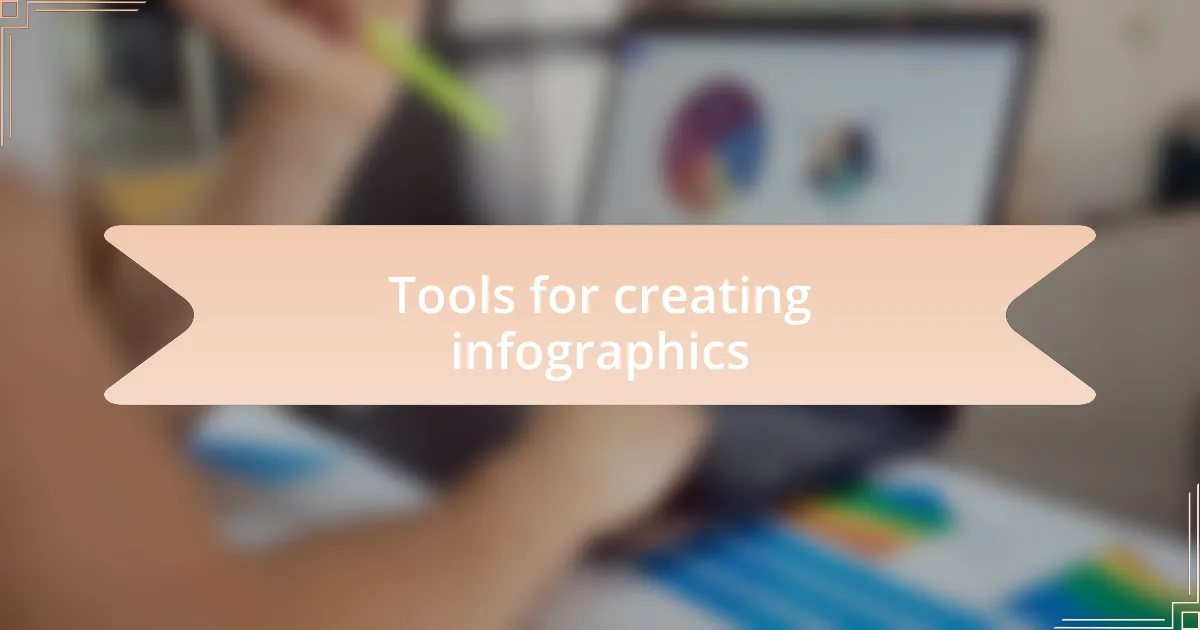
Tools for creating infographics
When it comes to tools for creating infographics, I often turn to platforms like Canva and Piktochart. They provide user-friendly interfaces that make designing engaging visuals a breeze, even for those who may not have extensive graphic design experience. In my early days of creating infographics, I found Canva’s extensive library of templates incredibly useful; it allowed me to focus on content rather than getting bogged down by design challenges. Have you ever struggled with where to start? A good template can really take the pressure off.
Another tool I love is Adobe Illustrator. It offers much more flexibility and precision for advanced users. I remember using it for a project on renewable energy sources, where I needed to create detailed icons and graphs. The ability to manipulate every element gave me a sense of control, and the final product was visually stunning. If you’re comfortable with a steeper learning curve, Illustrator can truly elevate your infographic game.
For quick infographics, I find Venngage to be a solid choice. When I needed to create a last-minute visual for a workshop, I was impressed by how easily I could generate charts and infographics on the fly. Don’t you think having a reliable tool handy when deadlines loom can be a lifesaver? It allows you to remain creative and focused without sacrificing quality.
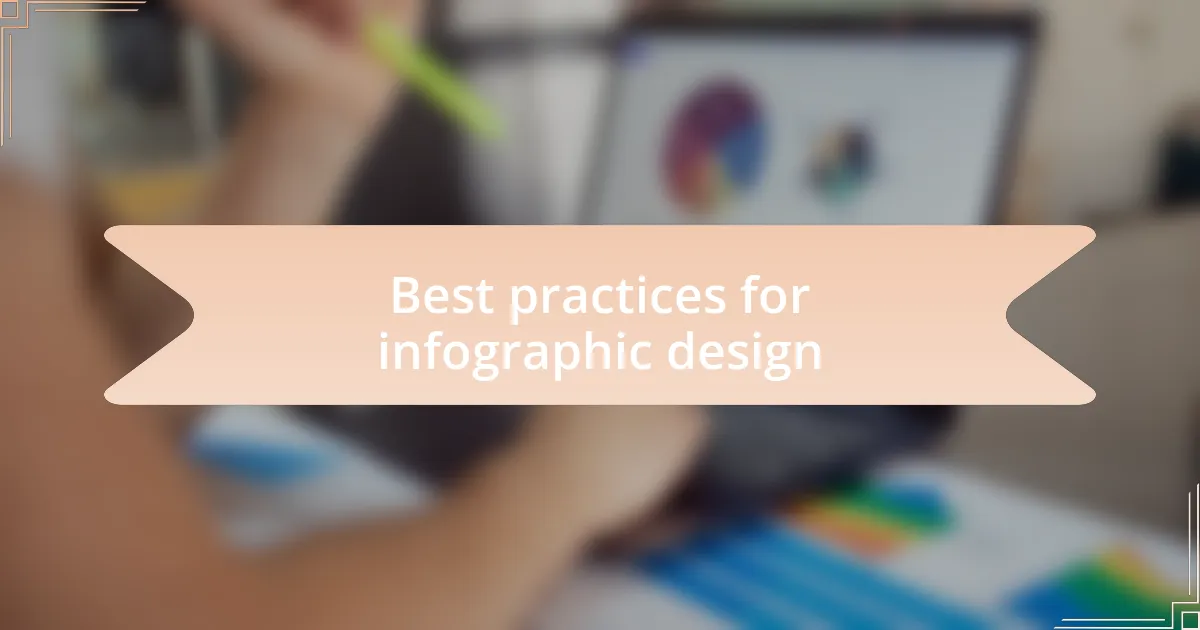
Best practices for infographic design
When designing infographics, clarity is paramount. I remember a time when I spent hours crafting an intricate infographic only to realize later that the message was muddled. By using a clear hierarchy, including headings, subheadings, and bullet points, I found that my audience could digest the information much faster. Have you ever glanced at an infographic and just felt overwhelmed? Simplifying your layout can make all the difference.
Color is another element I’ve learned to utilize wisely. Each time I experiment with a new color scheme, I aim for a combination that is not only eye-catching but also enhances readability. There was a project where I used a monochromatic palette, which helped unify the elements while ensuring that the text stood out. What colors resonate with your brand? Finding that perfect balance can transform your infographic from mediocre to memorable.
Finally, I discovered that integrating storytelling into my designs creates a deeper connection with the audience. Recently, I created an infographic on the impact of climate change, weaving narratives and statistics together. I noticed that using relatable anecdotes drew readers in and made complex data more accessible. How can your story be conveyed in an infographic? When you share not just the facts but also the feelings behind them, you engage your audience on a whole new level.

My personal infographic creation process
Creating an infographic begins with brainstorming ideas that resonate with me. I often start by jotting down the core message I want to convey, sometimes even sketching rough layouts to visualize how the elements could fit together. It’s like piecing together a puzzle, and the excitement builds as I refine my ideas into a coherent narrative. Have you ever felt that spark of inspiration when the pieces finally align?
Once I have a solid concept, I dive into gathering relevant data. I recall an occasion where I unearthed surprising statistics about consumer behavior that completely changed the direction of my infographic. That thrill of discovery reminds me why I love this process; it’s not just about visuals, but about telling a story backed by compelling facts. How do you feel when you find the perfect piece of information that adds weight to your narrative?
The design phase is where the real magic happens for me. I focus on creating a visual flow that guides the reader’s eye naturally from one section to another. A memorable experience was when I experimented with animated infographics for the first time—watching the data come to life was invigorating! It made me realize that interactivity could greatly enhance engagement. Have you explored animation in your infographics? It can truly elevate the viewer’s experience, making it more interactive and enjoyable.
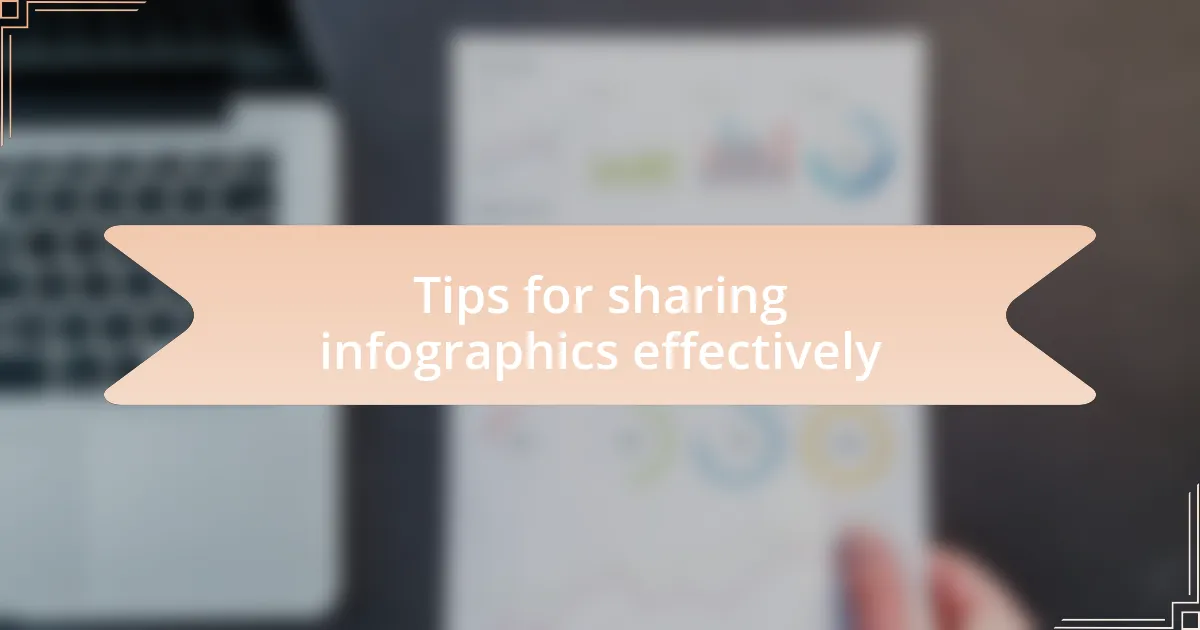
Tips for sharing infographics effectively
When it comes to sharing infographics effectively, timing is everything. I remember a time when I posted an infographic on social media around lunch hour, and the engagement skyrocketed. It taught me the importance of understanding when my audience is most active. Have you thought about the best times to share your content?
Another key tip is tailoring your message for each platform. While a more professional tone works well on LinkedIn, I find a casual, fun approach resonates better on Instagram. I once experimented by creating platform-specific versions of the same infographic, and the results were eye-opening. Have you ever considered how the same content might be perceived differently depending on where it’s shared?
Don’t forget to engage with your audience post-sharing. I’ve found that responding to comments and encouraging questions can create strong connections. It transforms a simple graphic into a conversation starter. Wouldn’t it be great to turn your infographic into a springboard for dialogue?